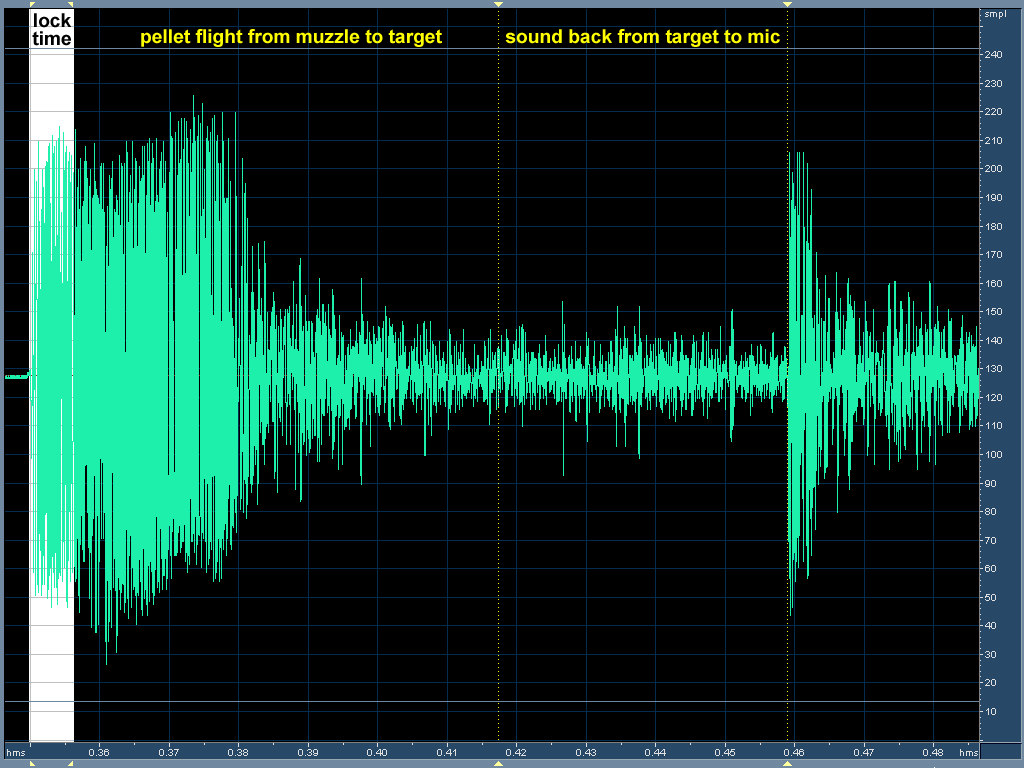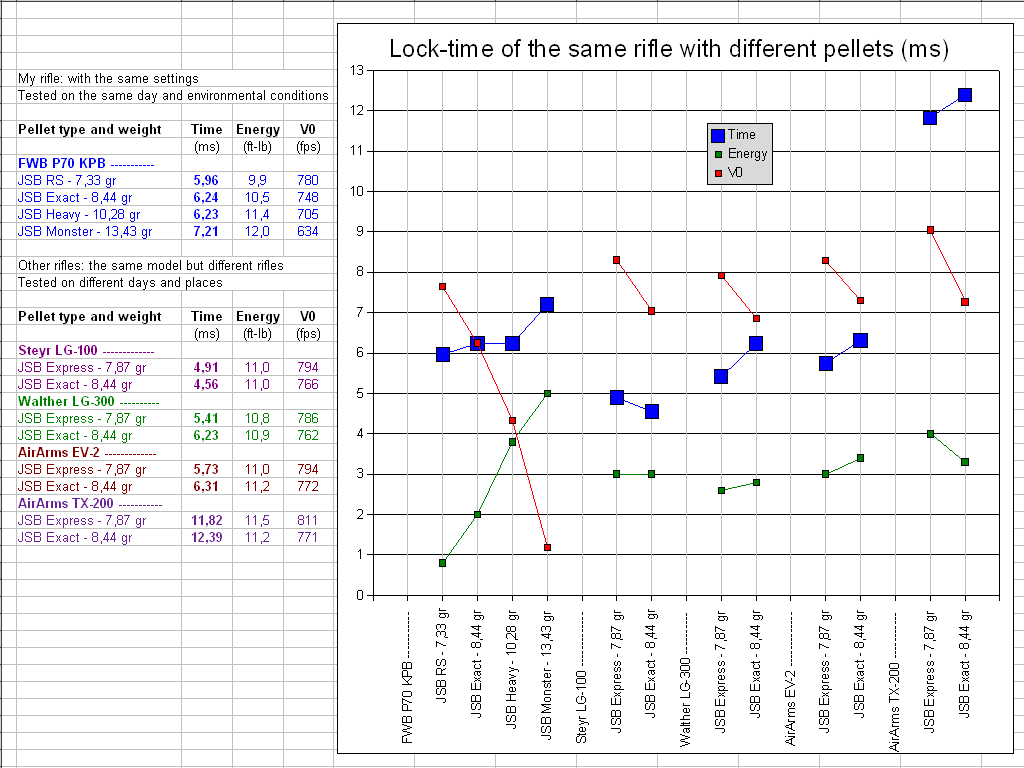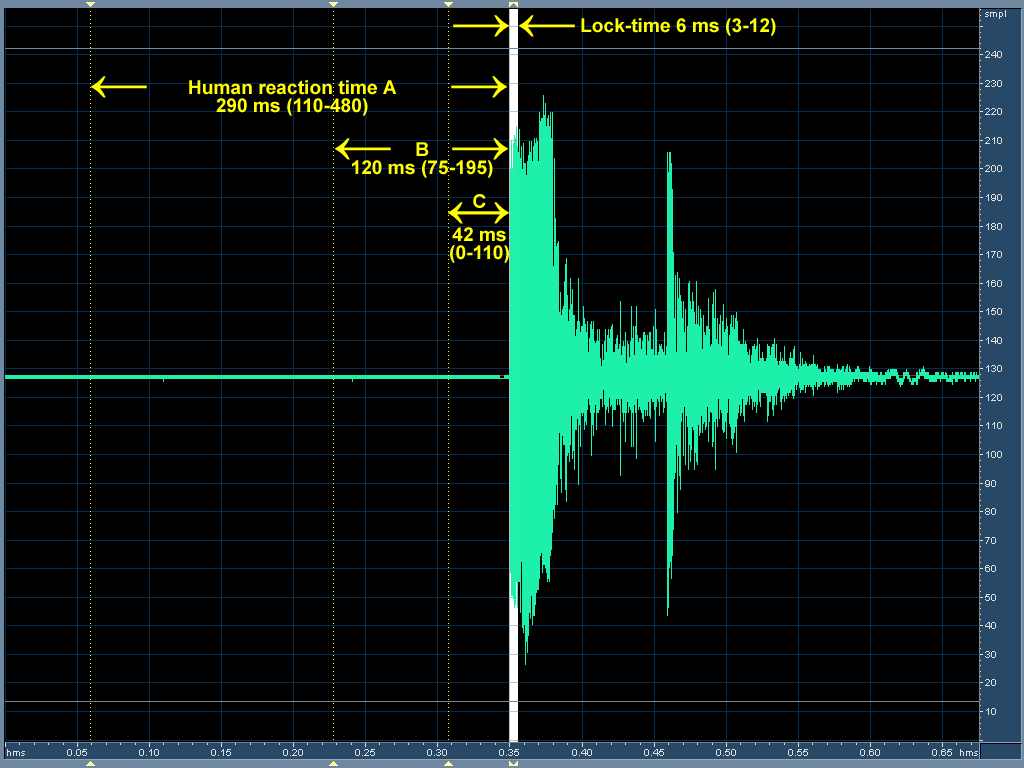Written by
András Fekete-Móró
Architect, born in 1971, now living and shooting in the UK
FT Hungarian Champion 2008-2009, World's 6th in 2010 / 9th in 2012
SUMMARY
Measured with a simple test how much time the pellet spends in the rifle from releasing the trigger until leaving the muzzle, and measured the human reaction time in different ways. Found that lock-time is negligible, compared to our own reaction time.
INTRODUCTION
As you may know, I've been testing the lock times of different rifle & pellet combinations in the last few days. My goal was to see what is the difference is between the most used rifles and a further goal to see whether this is important at all.
Let's make it clear that this is not the same lock-time as in the firearms, where lock-time means the time from the trigger release to the strike of the firing pin. Our lock-time is the total time what the pellet spends in the rifle before it leaves the muzzle. We don't give a damn when and what those small parts do inside, how piston, air, valves and pellet move – we're chasing only the total time while our movements can still affect the pellet after the shot release.
PART I – THE LOCK-TIME
Testing method
Since I still haven't won the lottery I don't have an air conditioned and well-equipped rifle testing laboratory, so I had to do this all with quite simple tools: a notebook with a headset, a laser distometer and a measuring tape, plus some knowledge about ballistics and physics. I don't want to bore anybody with the backstage secrets, but the main theory is that we can measure the total time of a shot and if we subtract the time what the pellet needs from the muzzle to the target and the time the sound needs to bounce back, then we have the time from trigger to muzzle.
Testing process
I pushed the microphone to the action and recorded the sound of a couple of shots at a 15 yds target. With a sound editor software I could then see with 0.1 ms accuracy how much time it took from the trigger's release until the sound of the hit bounced back to the microphone. I measured the muzzle-target and muzzle-microphone distance for each rifle, and recorded some environmental variables as temperature, altitude and barometric pressure. Of course I had to know the pellet type and velocity as well.
Accuracy of the test
Here is a small collection about how much deviance will occur from a particular measuring inaccuracy:
- 5 fps more velocity = 0.40 ms more lock-time (we used club chronographs)
- 5 cm more muzzle-target distance = 0.38 ms less time (measured with laser but a few cm movement could happen)
- 5°C more temperature = 0.42 ms more time (measured with my thermometer)
- 50 mbar more air pressure = 0.14 ms less time (I had the air pressure from weather archives)
- 100 m more altitude = 0.03 ms more time (I had the altitudes from Google Maps)
- 3 cm longer barrel = 0.14 ms less time (in case of silencer/stripper we didn't always see the muzzle)
This means that a bit low-reading chronograph or even a few cm difference in gun position can cause several tenth ms difference in calculated lock-time! So if your rifle has 0.2 ms less lock-time than your fellow shooters' then don't mock them too loudly because all these results are to be understood with ±0.5 ms tolerance...
And now the results
I found four distinct groups of rifles which are the following:
1. Electronic firing system = 3 ms
2. Regulated PCP rifles = 5-6 ms
3. Unregulated PCP rifles = 9 ms
4. The springer rifles = 12 ms
Let's notice that the same type of rifle produced different results with a different pellet, usually better times with the lighter pellets but not always. Of course the energy of the rifles was not exactly the same, and anyway the same rifle shoots with different energy if an other type of pellet is used. Once again, don't meditate too much over the fractions, what matters is before the comma my friends. As you can see the energy has not too much to do with the lock-time, it depends much more on the velocity of the pellet with an inverse ratio.
Effects of different pellet types
I made a table for a 'Same Rifles – Different Pellets' comparison. Please note that only the first part is really fair because that was made with the same rifle (my FWB) with the same settings on the same day and in the same environmental conditions. I was shooting 5-5 with each kind of pellet through a Combro chrony to a 15 yds target and repeated this cycle 3 times. The graphs show two things (none of them is too surprising anyway):
– The heavier pellet type we use, the more energy it can achieve from the same (PCP) rifle with the same settings,
– The higher the velocity, the shorter the lock time.
And if I had set my rifle for every pellet to shoot with the same energy then the lighter pellet would have had even more velocity and thus even shorter lock-time.
The other results with the other rifles are not so coherent because they were done only with the same model but not that particular one, on different days with different conditions. And the differences in lock-times are bigger because those rifles all had been set to 11-11.5 ft-lb so they had bigger difference between the velocities of Express and Exact compared to the measurings with the same rifle. The tendency is the same of course, the only exception were the Steyrs but still within the measuring tolerance.
PART II – THE REACTION TIME
Process of the test
I used the good old sound recorder again, made a 4 second long silent sound file with a 10 ms beep and played it continuously. The cursor of the software moved like a crosshair towards the target and I took my rifle and tried to fire as quickly as I could. This means a huge snatching on the trigger so I didn't care about squeezing or a surprise shot – just wanted to shoot very quickly.
While the programme played the beeps I recorded everything. The sound card could not fully suppress its own sound so we can see the beep on the record as a small peak beneath the shot sound and can measure the difference between them.
I measured three types of my reaction time:
A) First I didn't look at the screen and only when I heard the beep I tried to shoot as quickly as possible. These were quite poor results, the average 290 ms (110-480 ms values measured). But this is not too relevant since we can see the crosshair moving towards the target so we can prepare for the shot.
B) This time I followed the crosshair and tried to shoot right in the moment when it reached the target. I didn't start the shot earlier but I could see it getting closer and closer and when it was just on, I quickly fired. I found out that when I thought that 'I'm shooting NOW' and when I really released the shot, these two do not occur at the same moment at all – in reality they are about 120 ms apart (75-195 ms values).
C) Then I tried to shoot like the running target shooters, observing the crosshair moving and starting the shot earlier in order to eliminate this 120 ms lack. This was already much better, I had an average 42 ms time (0-110 ms values). I think that with a lot of practice I could have pushed down my average to 10-20 ms or even less, but let's not forget that the crosshair's movement had only one constant speed and the crosshair can move much slower or faster, too.
PART III. – CONCLUSIONS
What does this all mean for us? I know that all these tests represent only my reaction time but there are younger and older shooters in the scene so we can take my results as a good average and draw some general conclusions:
– Rifles shoot much faster than we believe,
– We shoot much slower than we believe.
The most important thing is that between what we THINK when we release the shoot and when we REALLY DO release the shot is 120 ms, which is about 20 times more than the lock-time of an average rifle. This suggests two things:
– Making huge efforts to reduce the lock time with 1-2 ms is not too effective.
– Doing follow through is damned very über mega effective.
* * * * * * * * * * * * * * * * * * * * * * * * * * * * * * * * * * *
© THIS ARTICLE IS COPYRIGHTED
Please do not publish it in any form on other places, do use this link instead:
http://www.szottesfold.co.uk/2012/02/lock-time-test-results.html
* * * * * * * * * * * * * * * * * * * * * * * * * * * * * * * * * * *
Other articles about air rifle shooting can be found under the label Shooting Articles.







0 komment:
Megjegyzés küldése